April is Sjögren’s Awareness Month. Sjögren’s is one of the most prevalent but still lesser-known autoimmune diseases, affecting an estimated 4 million Americans. Using our #ThisIsSjögrens online campaign, this April we are featuring 30 real patients to show the impact of this complex disease.
Every day in April, we will highlight a different patient using one or more of our social media channels, to create a better understanding of the disease. While the daily posts will each give one small glimpse into living with Sjögren’s, by the end of April, we hope these 30 posts will help others understand that the disease is serious, systemic and prevalent.
Every day is an opportunity to start a conversation about Sjögren’s and how it affects you. Below are different ways that you can be involved in our April 2021 Awareness Campaign and support the Foundation. Together, we will conquer the complexities of Sjögren's! Get involved:
2021 This is Sjögren's
Sjögren’s (“SHOW-grins”) is a systemic autoimmune disease that affects the entire body. Along with symptoms of extensive dryness, other serious complications include profound fatigue, chronic pain, major organ involvement, neuropathies, and lymphomas.
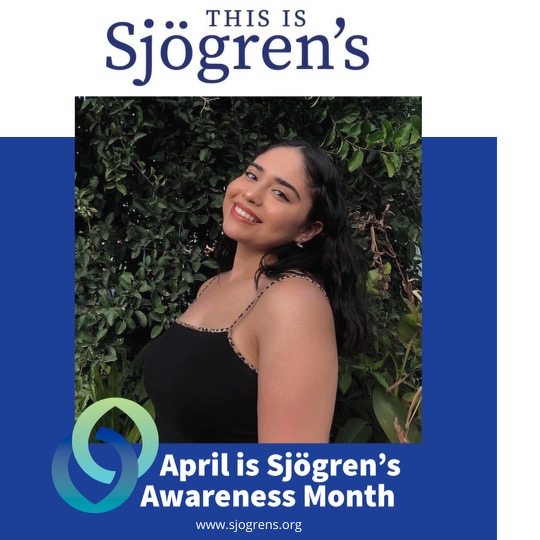
Day 1: Adoré 20 (diagnosed at 14)
Sjögren’s is a serious and systemic disease that affects your entire body. I wish people understood that it’s not easy to live Sjögren’s and somedays symptoms can hit you like a bus out of nowhere. I find strength in this community because I know I’m not the only one struggling and I want to be there for other patients. #ThisIsSjögrens
Click here to learn more about Sjögren’s symptoms.

Day 2: Kenya 47 (diagnosed at 43)
Since I was diagnosed with Sjögren’s, I have learned that I am stronger than I thought I was. With this disease I have to be! My three most difficult Sjögren’s symptoms are muscle pain, joint pain and fatigue. The pain I experience is sometimes unbearable. #ThisIsSjögrens
Click here to learn more about chronic pain and Sjögren's
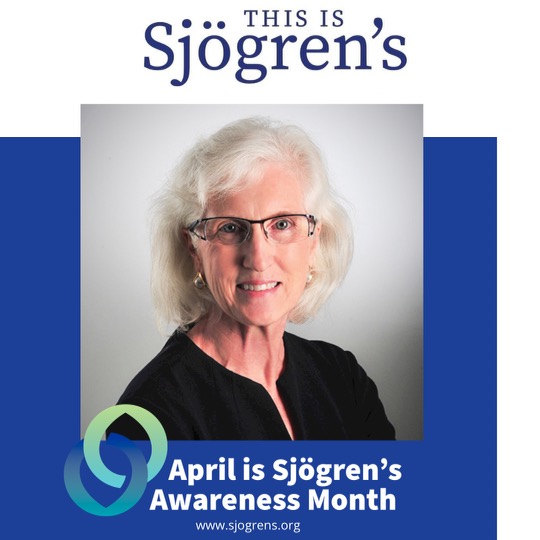
Day 3: Ellen 61 (diagnosed at 42)
My three most difficult Sjögren’s symptoms are fatigue, dry eyes and a dry cough (which, based on the looks I get, is often mistaken for COVID-19). To effectively cope with my disease, I’ve had to accept that taking multiple medications is OK. It was a hard decision because I had tried various diets/supplements/etc and I couldn't make it work for me. #ThisIsSjögrens
Click here to learn more about dry cough and pulmonary manifestations of Sjögren’s.

Day 4: Ingrid 35 (diagnosed at 30)
The Sjögren’s community and the Foundation has been a great source of comfort for me, especially in the beginning when I was told that the only symptoms for Sjögren’s would be dry eyes and dry mouths. The research publications and awareness efforts of the Foundation has lent credibility to my complaints of systemic symptoms. It has helped me to educate my family members and even some physicians about my condition. #ThisIsSjögrens
Click here to learn more about systemic manifestations in Sjögren's patients.
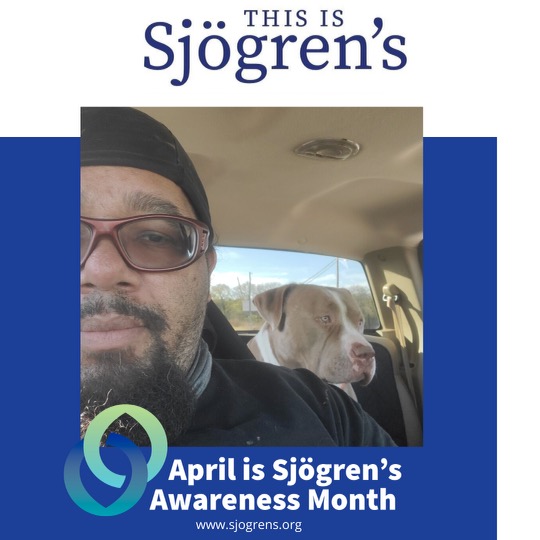
Day 5: Dominick 45 (diagnosed at 32)
It’s important to know that Sjögren’s symptoms mimic other illnesses and this disease doesn’t only affect women. More men are being diagnosed every day. If you are living with Sjögren’s, do not let a physician tell you that they can't help you. There is help. I know it’s difficult but if your doctor doesn't know about the disease, find one that does. #ThisIsSjögrens
Click here to learn more about Sjögren's in men.
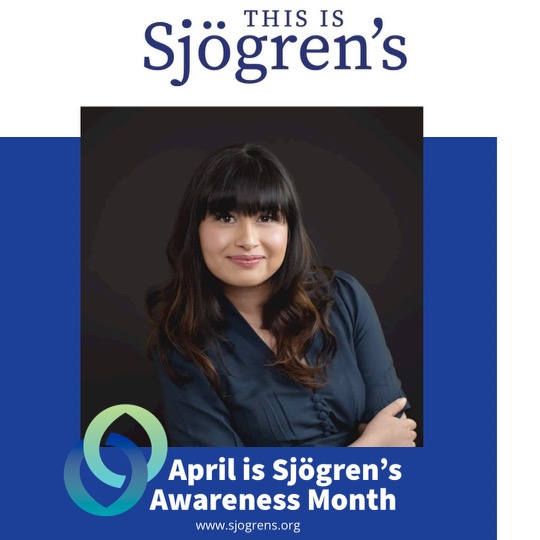
Day 6: Cassandra 40 (diagnosed at 35)
My best Sjögren’s tip is it’s okay to say NO. This disease sucks your energy in a way that healthy people cannot understand. Sometimes you have to say no to parties or gatherings. If you are tired or know that you need to conserve energy for the next day. It's upsetting, but friends and family should understand. Don’t push yourself into a disease flare. #ThisIsSjögrens
Click here to learn more about Sjögren's fatigue.
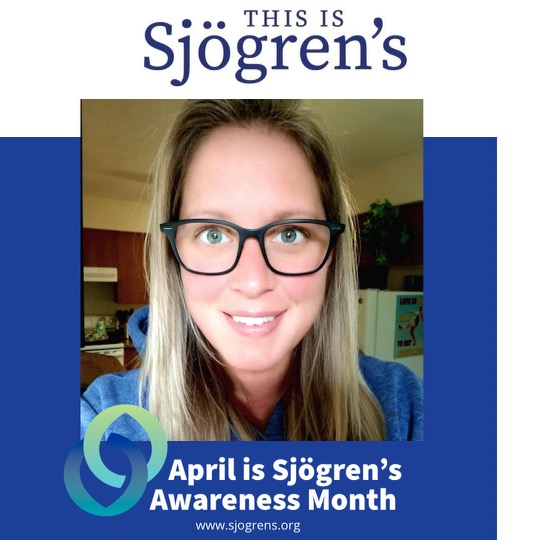
Day 7: Char 40 (diagnosed at 38)
Sjögren’s means I struggle to do what used to be simple tasks. I’ve accepted that my diagnosis isn’t my fault and I must be patient and kind with myself. I'm committed to helping bring awareness to this disease, because a lot of people have still never heard of Sjögren’s. #ThisIsSjögrens
Click here to learn about ways to raise awareness and become more involved with the Foundation.
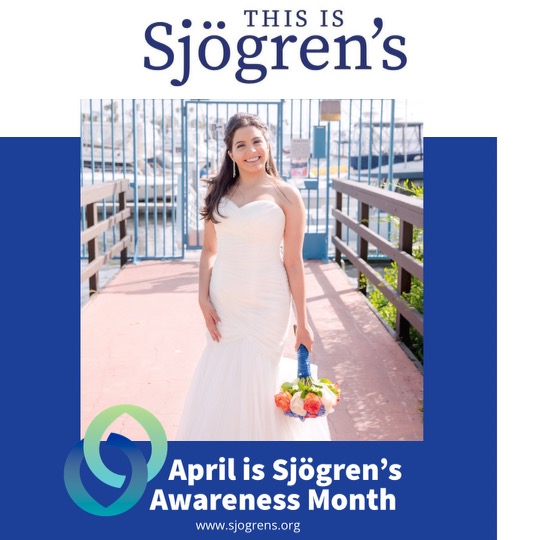
Day 8: Isabel 28 (diagnosed at 20)
My most difficult Sjögren’s symptoms are dry eyes, dry mouth, joint pain, fatigue, brain fog and peripheral neuropathy. Even though I’m not able to do everything that I once could, I won't let this disease stop me from achieving my personal and professional goals. #ThisIsSjögrens
Click here to learn more about the top five Sjögren’s complications that your rheumatologist should be monitoring for.
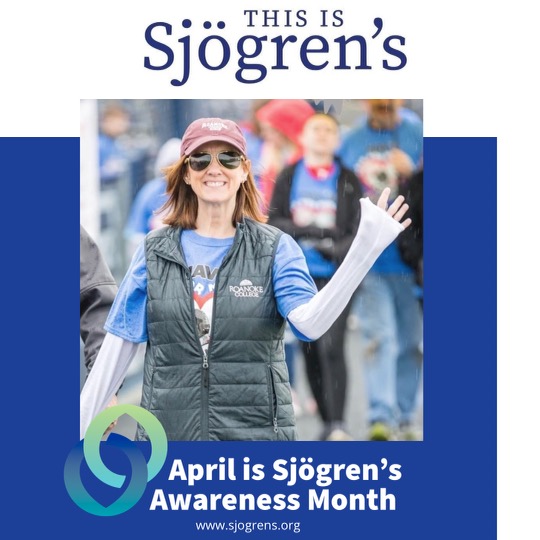
Day 9: Cyndi 52 (diagnosed at 43 after being misdiagnosed for 5 years)
Since I was diagnosed with Sjögren’s, I have learned to find my voice, know my limitations and not be ashamed when my body is telling me to take a step back. I want to encourage all patients to find their voice. It took me years to find mine. Don’t be silent – don’t try to hide your disease – once you own it, you actually gain all of your power back! #ThisIsSjögrens
Learn more about becoming a member of the Sjögren’s Foundation and receiving our newsletter, Conquering Sjögren’s.
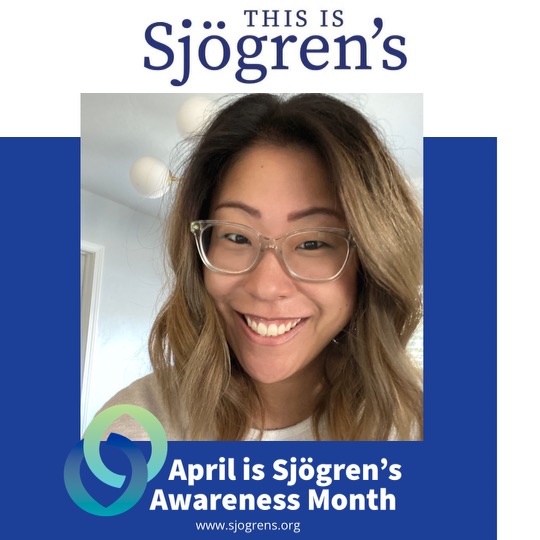
Day 10: Suzanne 34 (diagnosed at 33)
I wish people understood that even though I don’t look sick, there are days when I can’t function. I rarely talk about how bad I’m feeling because I look “okay,” but there are many times when I actually feel awful. If you’re living with Sjögren’s, know that you’re not alone. #ThisIsSjögrens
Click here to learn more about Sjögren’s.

Day 11: Lauren 36 (diagnosed at 36)
I’ve never spoken about my illness before and I went undiagnosed or 19 years. I first became symptomatic when I was 17 years old, which forced me to be homeschooled by the end of high school. My ophthalmologist suspected Sjögren’s, but healthcare professionals were baffled by my “normal” test results. I was officially diagnosed with a lip biopsy. As a patient, no one is going to advocate better for you than you can. If I hadn’t, I would never have been properly diagnosed. #ThisIsSjögrens
Click here to learn more about diagnosing Sjögren’s.
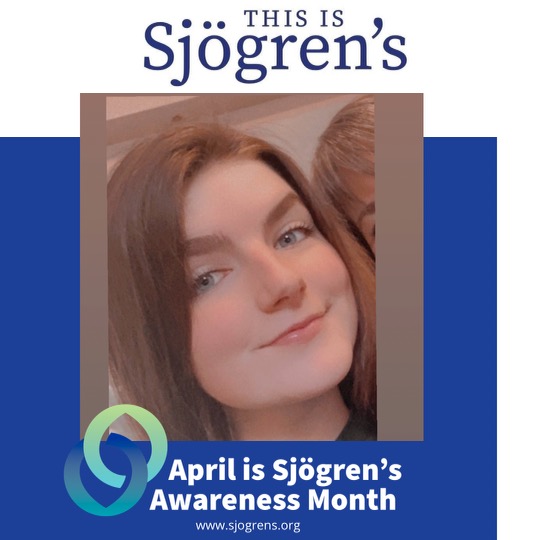
Day 12: Grace 15 (diagnosed at 8)
When I was diagnosed, I vividly remember riding the escalator to leave Children's hospital. My diagnosis was a word I couldn't pronounce and half the kids at school didn’t believe I was sick. I tried to “suck it up” and learned to dismiss my symptoms because I didn't want to be seen as attention-seeking. The only place that ever got me was in the ER. It’s important to educate people about this disease. #ThisIsSjögrens #PediatricSjögrensAwarenessDay
*Sjögren’s in children is likely more common than currently appreciated.
Click here to learn more about Sjögren’s in children.
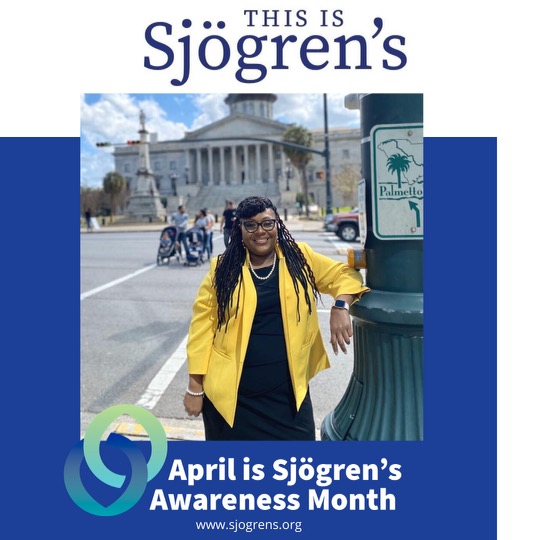
Day 13: Robin 50 (diagnosed at 49)
The Sjögren’s community gives me strength because I know I am not alone in this battle. My job is demanding, but I have learned to slow down and rest. My best tip is to listen to your body. No one knows it better than you. It's okay to take of yourself. #ThisIsSjögrens
Click here to learn more Sjögren’s tips.
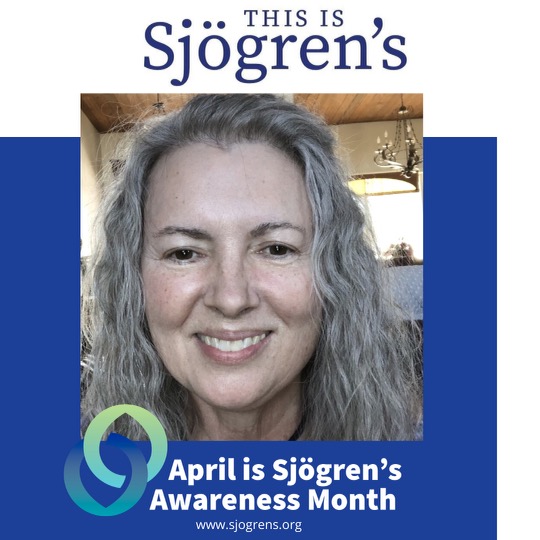
Day 14: Lily 59 (diagnosed at 58)
I wish others knew that my outward appearance is not a gauge of how I feel or what is going on with my health. Sjögren’s means that I live with dizziness, fatigue, dryness, small fiber neuropathy, and heat/cold intolerance. Being a systemic disease, it seems like my symptoms are ever-changing. I find hope knowing that we have the Sjögren’s Foundation advocating for us. #ThisIsSjögrens
Click here to learn more about the Sjögren’s Foundation’s impact.
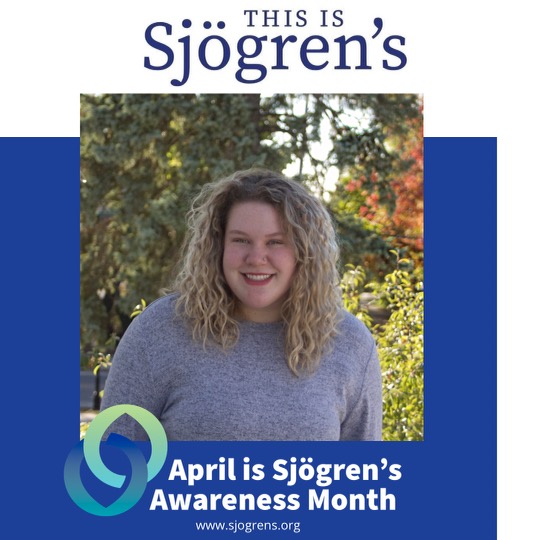
Day 15: Hannah 20 (diagnosed at 20)
Since I was diagnosed with Sjögren’s, I have learned that my symptoms are valid and it is incredibly important to listen to my body. I struggle with salivary gland pain, salivary gland blockages, and dry mouth. To cope with my symptoms, I have undergone a sialendoscopy procedure to flush one of my glands. #ThisIsSjögrens
Click here to learn how to massage your salivary glands with Sjögren’s.
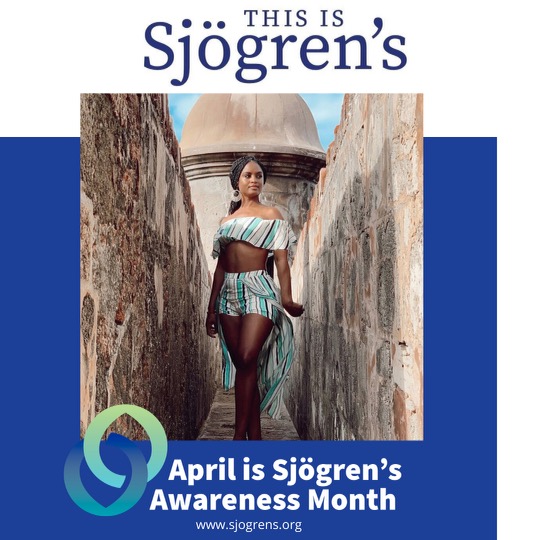
Day 16: Allissa 29 (diagnosed at 11)
Sjögren’s has taught me what it means to be adaptable, what it means to be honest with yourself, and what it means to persevere through fear and uncertainty. #ThisIsSjögrens
Click here to learn more about Special Foundation Support Groups like 20s & 30s with Sjögren’s.
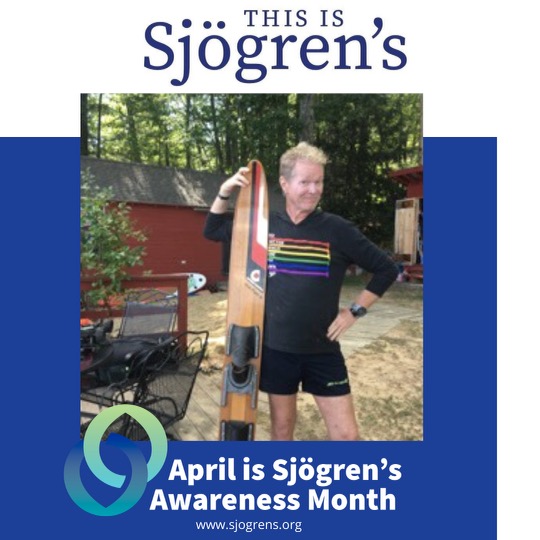
Day 17: Tom 66 (diagnosed at 63)
I wish others understood that Sjögren’s can take many forms and its symptoms are chronic battles affecting us physically and emotionally. It is a disease that often those around us too. Since I was diagnosed with Sjögren’s, I have learned everything I can to better prepare myself for the symptoms and repercussions. #ThisIsSjögrens
Click here to learn more about physically and emotionally burdens of Sjögren’s.
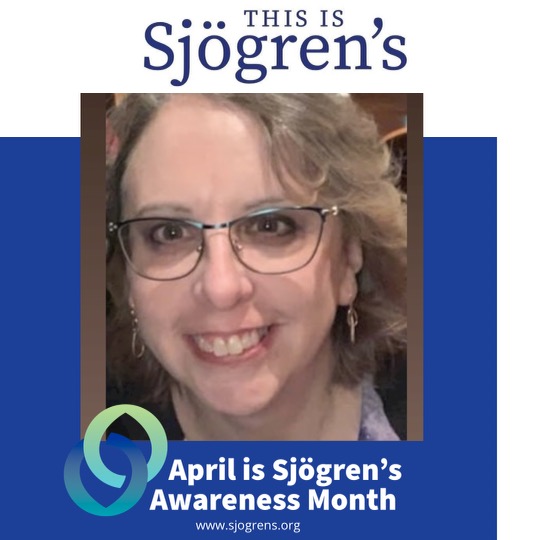
Day 18: Teresa 55 (diagnosed at 43)
Sjögren’s isn’t just dry eyes and mouth. For me it is joint pain, neuralgia and extreme fatigue. This disease is real and disabling. The Sjögren’s community has been wonderful with helpful tips of how to cope and successful treatment ideas. I have also found a lot information on available clinical trials and I was recently chosen to participate in one. #ThisIsSjögrens
Click here to learn more about Sjögren’s clinical trials.
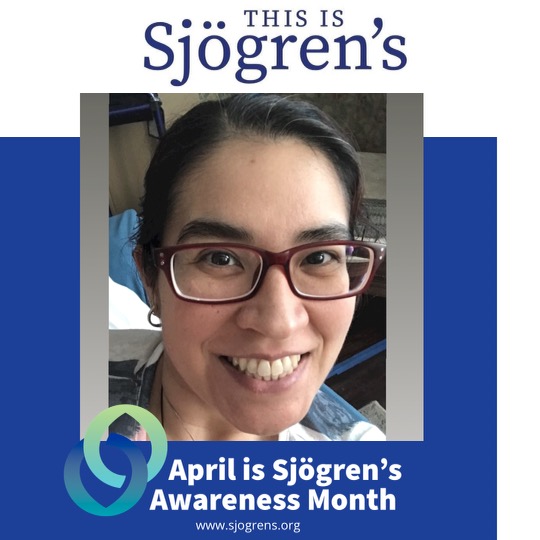
Day 19: Adriana 35 (diagnosed at 30)
Not all illnesses are visible. Believe us when we say we are not having a good day and are doing all we can to look as good as we can. #ThisIsSjögrens
Click here to learn more about Sjögren’s resources.

Day 20: Silja 49 (diagnosed at 40)
My best Sjögren’s tip would be to listen to your body and learn new ways to be healthy, regain control and find joy again. Mourn the “old you” if you need to, but then discover the “new you” with compassion and curiosity. Exercise is one way that helps me cope with symptoms. Instead of long cardio sessions and heavy weights, I now stretch, do yoga, take walks and do smaller (10 minute) low impact cardio sessions that don’t tire me out too much. #ThisIsSjögrens
Click her to view our blog post, “Yoga and Sjögren's: There's a Pose for That!”
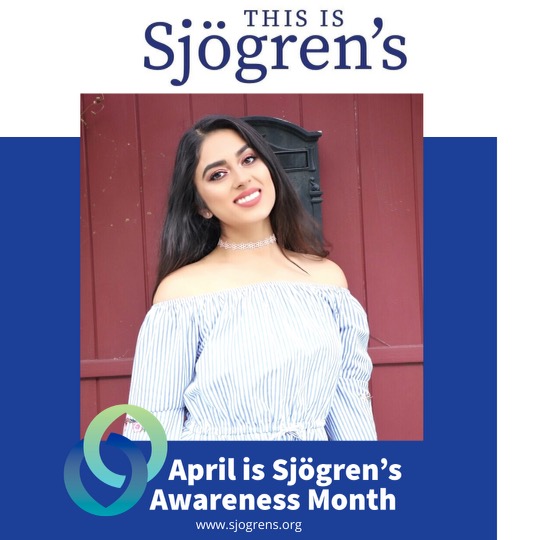
Day 21: Sophia 29 (diagnosed at 29)
Since I was diagnosed with Sjögren’s, I have learned that I am much more resilient than I ever thought. It took many hospitals, doctors and 12 years for me to be diagnosed. I wish people acted with compassion first before judging a book by its cover. There are challenges we face that some may never see, and we need support. Sjögren’s can look like me, or you. #ThisIsSjögrens
Click here to learn more about understanding Sjögren’s.
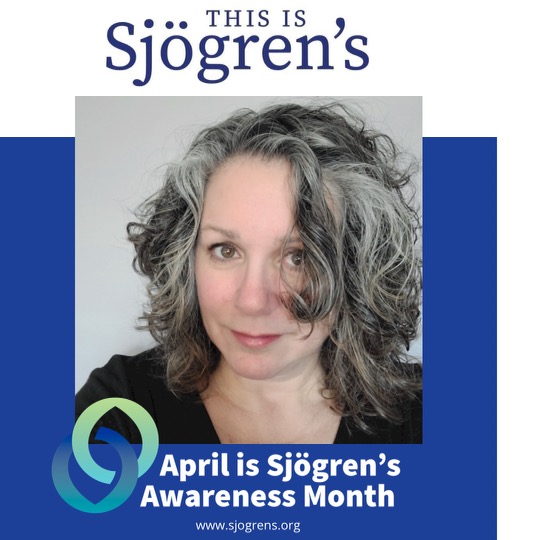
Day 22: Laurie 55 (diagnosed at 53)
One of the hardest things to do when you are in a Sjögren’s flare, is to do anything. On the days when I just can't, there is nothing better than a heating pad, a fluffy dog and a good movie. My best advice is to surround yourself with positivity. Find support in the Foundation and their resources. Fight for yourself, trust your body and find a provider who hears you. #ThisIsSjögrens
Click her to learn more about membership to the Sjögren’s Foundation.
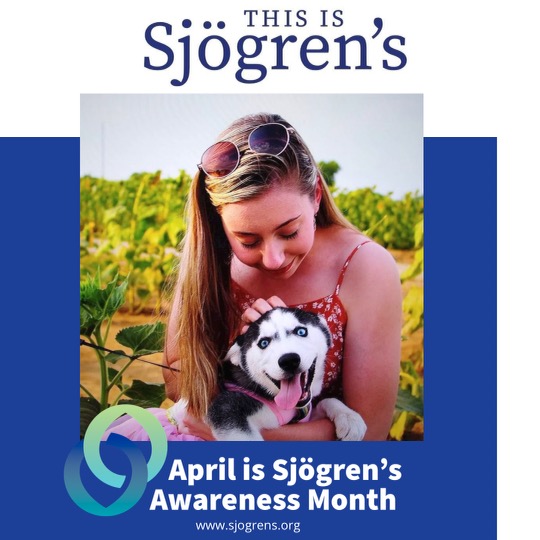
Day 23: Jaden 18 (diagnosed at 16)
Having an autoimmune disease is taxing, but the Sjögren’s community makes me feel less alone. I’m so thankful to have received my diagnosis when I did and hope that through continued awareness and research, others will be able to as well. I’m not lazy, I’m not weak, and I’m not crazy. I have to remind myself that there are legitimate reasons for me to be tired, sore, or emotionally run down. #ThisIsSjögrens
Click here to learn more about Living with Sjögren’s.
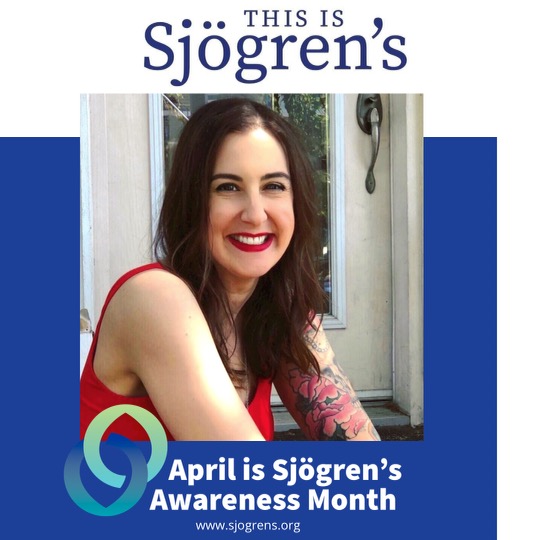
Day 24: Melissa 40 (diagnosed at 35)
Since I was diagnosed with Sjögren’s, I’ve developed a wicked sense of humor and that helps me to cope. I initially had trouble getting taken seriously because my symptoms were non-specific. My first experience with a rheumatologist was terrible – I used to leave my doctor’s appointments in tears. I realized that I couldn’t continue to place my health in this person’s hands. I’m happy to say that I now have a wonderful healthcare team, who take great care of both my physical and mental health. #ThisIsSjögrens
Click here to learn more about Sjögren’s and preparing for a new doctor’s visit.
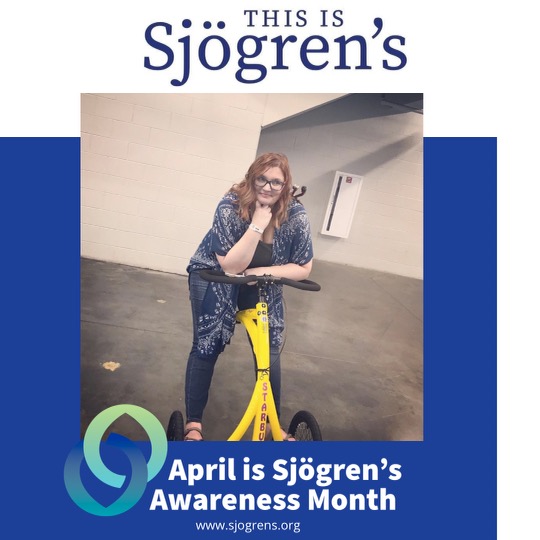
Day 25: Tracey 44 (diagnosed at 41)
If you’re newly diagnosed with Sjögren’s, don’t panic. You have a community to reach out to for advice and support. Every patient needs different ways to manage their symptoms and the disease. Know that a lot of it is learning what works for you. Be kind to yourself, and never give up! #ThisIsSjögrens
Click here to learn about the Sjögren’s Foundation SmartPatients Community.
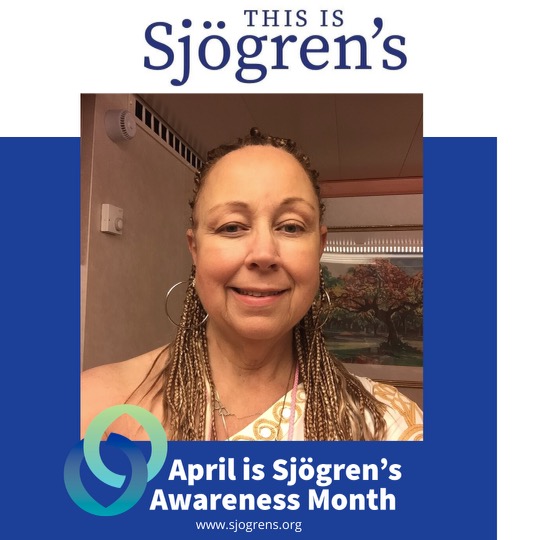
Day 26: Dianna 63 (diagnosed at 55)
My three most difficult symptoms are joint pain, fatigue and brain fog. Sjögren’s means I have to care for myself when the symptoms become unbearable. I’ve learned to not push through the pain or fatigue. I need to give my body the rest/care/treatment it needs to feel better. Massage, pain creams/patches and rest help me. #ThisIsSjögrens
Click here to learn more about Brain Fog and Sjögren’s.
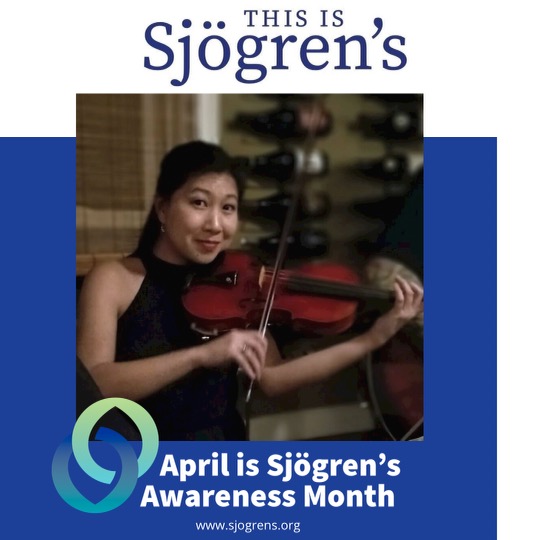
Day 27: Shirley 41 (diagnosed at 28)
My best Sjogren’s tip is to make your health a priority, so you may have a better quality of life. During the pandemic, I started using a humidifier while teaching violin, as wearing a mask causes my breath to dry out my eyes. Other coping techniques I use are warm eye compresses, lubricating eye drops/ ointment, Restasis®, cevimeline, and a gluten-free diet. I wish people understood that my overactive immune system affects my entire body (eyes, nose, mouth, throat, thyroid, lungs, heart, digestive system, kidneys, skin.) #ThisIsSjögrens #TipTuesday
***For Sjögren’s patients, an optimal range of humidity is between 55% and 60% regardless of the ambient temperature.
Click here to learn more about Sjögren’s and Sinuses.
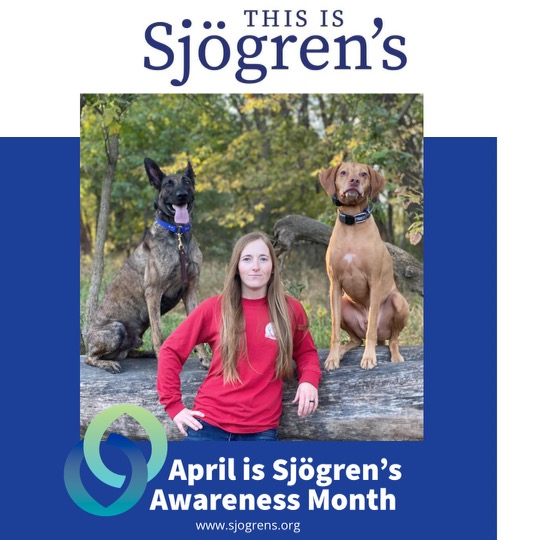
Day 28: Michele 28 (diagnosed at 21)
Since I was diagnosed with Sjögren’s, I have learned how to be more sympathetic to others because I never know what battles they are fighting, just like many do not know about my diagnosis. I often decline invitations to activities with friends and family because it can be extremely difficult mentally and physically to participate at times. I do care and wish to be involved, but sometimes my body cannot handle it. #ThisIsSjögrens
Click here to learn more about Sjögren's fatigue.

Day 29: Therese 48 (diagnosed at 47)
Sjögren’s has taught me that I am stronger than I ever thought possible. My best tip is don’t be afraid to seek mental health support. There is an emphasis placed on our physical healthcare needs, but receiving a chronic illness diagnosis has a huge impact on our mental health as well. We experience a grieving process and we need extra mental health support as we navigate our "new normal." I love the fact that the Foundation gives patients a sense of community and belonging - it helps to have that extra support and know we are not alone in our journey! #ThisIsSjögrens
Click here to learn more about Sjögren’s Foundation Town Hall Meetings, including our talk, "Coping with Stress & Anxiety."
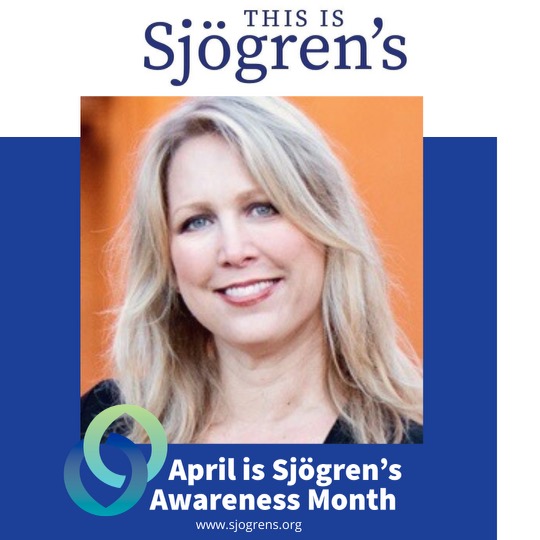
Day 30: Janet E. Church, Sjögren’s Foundation President & CEO
59 (diagnosed at 44)
Thank you for joining us this April to raise awareness of Sjögren’s! I hope our #ThisIsSjogrens campaign has inspired you as it has inspired me. As a patient myself, the Foundation has always been my go-to resource for education and support. And as CEO of the Sjögren’s Foundation, I want everyone in our community to know that we are here for you and we are fighting for you!
In addition to our patient programs, the Foundation places Sjögren’s in front of the medical and scientific communities as well as government agencies. We are leading the charge to ensure that this disease is recognized as systemic, serious, and prevalent so all patients get the care and support needed. Join me by becoming a member. Together, we can conquer the complexities of Sjögren’s! #ThisIsSjögrens
Click here to learn more about becoming a Foundation member.

April is Sjögren’s Awareness Month. Sjögren’s is one of the most prevalent but still lesser-known autoimmune diseases, affecting an estimated 4 million Americans. Using our #ThisIsSjögrens online campaign, this April we are featuring 30 real patients to show the impact of this complex disease.
Every day in April, we will highlight a different patient using one or more of our social media channels, to create a better understanding of the disease. While the daily posts will each give one small glimpse into living with Sjögren’s, by the end of April, we hope these 30 posts will help others understand that the disease is serious, systemic and prevalent.
Every day is an opportunity to start a conversation about Sjögren’s and how it affects you. Below are different ways that you can be involved in our April 2021 Awareness Campaign and support the Foundation. Together, we will conquer the complexities of Sjögren's! Get involved:
2021 This is Sjögren's
Sjögren’s (“SHOW-grins”) is a systemic autoimmune disease that affects the entire body. Along with symptoms of extensive dryness, other serious complications include profound fatigue, chronic pain, major organ involvement, neuropathies, and lymphomas.
Day 1: Adoré 20 (diagnosed at 14)
Sjögren’s is a serious and systemic disease that affects your entire body. I wish people understood that it’s not easy to live Sjögren’s and somedays symptoms can hit you like a bus out of nowhere. I find strength in this community because I know I’m not the only one struggling and I want to be there for other patients. #ThisIsSjögrens
Click here to learn more about Sjögren’s symptoms.
Day 2: Kenya 47 (diagnosed at 43)
Since I was diagnosed with Sjögren’s, I have learned that I am stronger than I thought I was. With this disease I have to be! My three most difficult Sjögren’s symptoms are muscle pain, joint pain and fatigue. The pain I experience is sometimes unbearable. #ThisIsSjögrens
Click here to learn more about chronic pain and Sjögren's
Day 3: Ellen 61 (diagnosed at 42)
My three most difficult Sjögren’s symptoms are fatigue, dry eyes and a dry cough (which, based on the looks I get, is often mistaken for COVID-19). To effectively cope with my disease, I’ve had to accept that taking multiple medications is OK. It was a hard decision because I had tried various diets/supplements/etc and I couldn't make it work for me. #ThisIsSjögrens
Click here to learn more about dry cough and pulmonary manifestations of Sjögren’s.
Day 4: Ingrid 35 (diagnosed at 30)
The Sjögren’s community and the Foundation has been a great source of comfort for me, especially in the beginning when I was told that the only symptoms for Sjögren’s would be dry eyes and dry mouths. The research publications and awareness efforts of the Foundation has lent credibility to my complaints of systemic symptoms. It has helped me to educate my family members and even some physicians about my condition. #ThisIsSjögrens
Click here to learn more about systemic manifestations in Sjögren's patients.
Day 5: Dominick 45 (diagnosed at 32)
It’s important to know that Sjögren’s symptoms mimic other illnesses and this disease doesn’t only affect women. More men are being diagnosed every day. If you are living with Sjögren’s, do not let a physician tell you that they can't help you. There is help. I know it’s difficult but if your doctor doesn't know about the disease, find one that does. #ThisIsSjögrens
Click here to learn more about Sjögren's in men.
Day 6: Cassandra 40 (diagnosed at 35)
My best Sjögren’s tip is it’s okay to say NO. This disease sucks your energy in a way that healthy people cannot understand. Sometimes you have to say no to parties or gatherings. If you are tired or know that you need to conserve energy for the next day. It's upsetting, but friends and family should understand. Don’t push yourself into a disease flare. #ThisIsSjögrens
Click here to learn more about Sjögren's fatigue.
Day 7: Char 40 (diagnosed at 38)
Sjögren’s means I struggle to do what used to be simple tasks. I’ve accepted that my diagnosis isn’t my fault and I must be patient and kind with myself. I'm committed to helping bring awareness to this disease, because a lot of people have still never heard of Sjögren’s. #ThisIsSjögrens
Click here to learn about ways to raise awareness and become more involved with the Foundation.
Day 8: Isabel 28 (diagnosed at 20)
My most difficult Sjögren’s symptoms are dry eyes, dry mouth, joint pain, fatigue, brain fog and peripheral neuropathy. Even though I’m not able to do everything that I once could, I won't let this disease stop me from achieving my personal and professional goals. #ThisIsSjögrens
Click here to learn more about the top five Sjögren’s complications that your rheumatologist should be monitoring for.
Day 9: Cyndi 52 (diagnosed at 43 after being misdiagnosed for 5 years)
Since I was diagnosed with Sjögren’s, I have learned to find my voice, know my limitations and not be ashamed when my body is telling me to take a step back. I want to encourage all patients to find their voice. It took me years to find mine. Don’t be silent – don’t try to hide your disease – once you own it, you actually gain all of your power back! #ThisIsSjögrens
Learn more about becoming a member of the Sjögren’s Foundation and receiving our newsletter, Conquering Sjögren’s.
Day 10: Suzanne 34 (diagnosed at 33)
I wish people understood that even though I don’t look sick, there are days when I can’t function. I rarely talk about how bad I’m feeling because I look “okay,” but there are many times when I actually feel awful. If you’re living with Sjögren’s, know that you’re not alone. #ThisIsSjögrens
Click here to learn more about Sjögren’s.
Day 11: Lauren 36 (diagnosed at 36)
I’ve never spoken about my illness before and I went undiagnosed or 19 years. I first became symptomatic when I was 17 years old, which forced me to be homeschooled by the end of high school. My ophthalmologist suspected Sjögren’s, but healthcare professionals were baffled by my “normal” test results. I was officially diagnosed with a lip biopsy. As a patient, no one is going to advocate better for you than you can. If I hadn’t, I would never have been properly diagnosed. #ThisIsSjögrens
Click here to learn more about diagnosing Sjögren’s.
Day 12: Grace 15 (diagnosed at 8)
When I was diagnosed, I vividly remember riding the escalator to leave Children's hospital. My diagnosis was a word I couldn't pronounce and half the kids at school didn’t believe I was sick. I tried to “suck it up” and learned to dismiss my symptoms because I didn't want to be seen as attention-seeking. The only place that ever got me was in the ER. It’s important to educate people about this disease. #ThisIsSjögrens #PediatricSjögrensAwarenessDay
*Sjögren’s in children is likely more common than currently appreciated.
Click here to learn more about Sjögren’s in children.
Day 13: Robin 50 (diagnosed at 49)
The Sjögren’s community gives me strength because I know I am not alone in this battle. My job is demanding, but I have learned to slow down and rest. My best tip is to listen to your body. No one knows it better than you. It's okay to take of yourself. #ThisIsSjögrens
Click here to learn more Sjögren’s tips.
Day 14: Lily 59 (diagnosed at 58)
I wish others knew that my outward appearance is not a gauge of how I feel or what is going on with my health. Sjögren’s means that I live with dizziness, fatigue, dryness, small fiber neuropathy, and heat/cold intolerance. Being a systemic disease, it seems like my symptoms are ever-changing. I find hope knowing that we have the Sjögren’s Foundation advocating for us. #ThisIsSjögrens
Click here to learn more about the Sjögren’s Foundation’s impact.
Day 15: Hannah 20 (diagnosed at 20)
Since I was diagnosed with Sjögren’s, I have learned that my symptoms are valid and it is incredibly important to listen to my body. I struggle with salivary gland pain, salivary gland blockages, and dry mouth. To cope with my symptoms, I have undergone a sialendoscopy procedure to flush one of my glands. #ThisIsSjögrens
Click here to learn how to massage your salivary glands with Sjögren’s.
Day 16: Allissa 29 (diagnosed at 11)
Sjögren’s has taught me what it means to be adaptable, what it means to be honest with yourself, and what it means to persevere through fear and uncertainty. #ThisIsSjögrens
Click here to learn more about Special Foundation Support Groups like 20s & 30s with Sjögren’s.
Day 17: Tom 66 (diagnosed at 63)
I wish others understood that Sjögren’s can take many forms and its symptoms are chronic battles affecting us physically and emotionally. It is a disease that often those around us too. Since I was diagnosed with Sjögren’s, I have learned everything I can to better prepare myself for the symptoms and repercussions. #ThisIsSjögrens
Click here to learn more about physically and emotionally burdens of Sjögren’s.
Day 18: Teresa 55 (diagnosed at 43)
Sjögren’s isn’t just dry eyes and mouth. For me it is joint pain, neuralgia and extreme fatigue. This disease is real and disabling. The Sjögren’s community has been wonderful with helpful tips of how to cope and successful treatment ideas. I have also found a lot information on available clinical trials and I was recently chosen to participate in one. #ThisIsSjögrens
Click here to learn more about Sjögren’s clinical trials.
Day 19: Adriana 35 (diagnosed at 30)
Not all illnesses are visible. Believe us when we say we are not having a good day and are doing all we can to look as good as we can. #ThisIsSjögrens
Click here to learn more about Sjögren’s resources.
Day 20: Silja 49 (diagnosed at 40)
My best Sjögren’s tip would be to listen to your body and learn new ways to be healthy, regain control and find joy again. Mourn the “old you” if you need to, but then discover the “new you” with compassion and curiosity. Exercise is one way that helps me cope with symptoms. Instead of long cardio sessions and heavy weights, I now stretch, do yoga, take walks and do smaller (10 minute) low impact cardio sessions that don’t tire me out too much. #ThisIsSjögrens
Click her to view our blog post, “Yoga and Sjögren's: There's a Pose for That!”
Day 21: Sophia 29 (diagnosed at 29)
Since I was diagnosed with Sjögren’s, I have learned that I am much more resilient than I ever thought. It took many hospitals, doctors and 12 years for me to be diagnosed. I wish people acted with compassion first before judging a book by its cover. There are challenges we face that some may never see, and we need support. Sjögren’s can look like me, or you. #ThisIsSjögrens
Click here to learn more about understanding Sjögren’s.
Day 22: Laurie 55 (diagnosed at 53)
One of the hardest things to do when you are in a Sjögren’s flare, is to do anything. On the days when I just can't, there is nothing better than a heating pad, a fluffy dog and a good movie. My best advice is to surround yourself with positivity. Find support in the Foundation and their resources. Fight for yourself, trust your body and find a provider who hears you. #ThisIsSjögrens
Click her to learn more about membership to the Sjögren’s Foundation.
Day 23: Jaden 18 (diagnosed at 16)
Having an autoimmune disease is taxing, but the Sjögren’s community makes me feel less alone. I’m so thankful to have received my diagnosis when I did and hope that through continued awareness and research, others will be able to as well. I’m not lazy, I’m not weak, and I’m not crazy. I have to remind myself that there are legitimate reasons for me to be tired, sore, or emotionally run down. #ThisIsSjögrens
Click here to learn more about Living with Sjögren’s.
Day 24: Melissa 40 (diagnosed at 35)
Since I was diagnosed with Sjögren’s, I’ve developed a wicked sense of humor and that helps me to cope. I initially had trouble getting taken seriously because my symptoms were non-specific. My first experience with a rheumatologist was terrible – I used to leave my doctor’s appointments in tears. I realized that I couldn’t continue to place my health in this person’s hands. I’m happy to say that I now have a wonderful healthcare team, who take great care of both my physical and mental health. #ThisIsSjögrens
Click here to learn more about Sjögren’s and preparing for a new doctor’s visit.
Day 25: Tracey 44 (diagnosed at 41)
If you’re newly diagnosed with Sjögren’s, don’t panic. You have a community to reach out to for advice and support. Every patient needs different ways to manage their symptoms and the disease. Know that a lot of it is learning what works for you. Be kind to yourself, and never give up! #ThisIsSjögrens
Click here to learn about the Sjögren’s Foundation SmartPatients Community.
Day 26: Dianna 63 (diagnosed at 55)
My three most difficult symptoms are joint pain, fatigue and brain fog. Sjögren’s means I have to care for myself when the symptoms become unbearable. I’ve learned to not push through the pain or fatigue. I need to give my body the rest/care/treatment it needs to feel better. Massage, pain creams/patches and rest help me. #ThisIsSjögrens
Click here to learn more about Brain Fog and Sjögren’s.
Day 27: Shirley 41 (diagnosed at 28)
My best Sjogren’s tip is to make your health a priority, so you may have a better quality of life. During the pandemic, I started using a humidifier while teaching violin, as wearing a mask causes my breath to dry out my eyes. Other coping techniques I use are warm eye compresses, lubricating eye drops/ ointment, Restasis®, cevimeline, and a gluten-free diet. I wish people understood that my overactive immune system affects my entire body (eyes, nose, mouth, throat, thyroid, lungs, heart, digestive system, kidneys, skin.) #ThisIsSjögrens #TipTuesday
***For Sjögren’s patients, an optimal range of humidity is between 55% and 60% regardless of the ambient temperature.
Click here to learn more about Sjögren’s and Sinuses.
Day 28: Michele 28 (diagnosed at 21)
Since I was diagnosed with Sjögren’s, I have learned how to be more sympathetic to others because I never know what battles they are fighting, just like many do not know about my diagnosis. I often decline invitations to activities with friends and family because it can be extremely difficult mentally and physically to participate at times. I do care and wish to be involved, but sometimes my body cannot handle it. #ThisIsSjögrens
Click here to learn more about Sjögren's fatigue.
Day 29: Therese 48 (diagnosed at 47)
Sjögren’s has taught me that I am stronger than I ever thought possible. My best tip is don’t be afraid to seek mental health support. There is an emphasis placed on our physical healthcare needs, but receiving a chronic illness diagnosis has a huge impact on our mental health as well. We experience a grieving process and we need extra mental health support as we navigate our "new normal." I love the fact that the Foundation gives patients a sense of community and belonging - it helps to have that extra support and know we are not alone in our journey! #ThisIsSjögrens
Click here to learn more about Sjögren’s Foundation Town Hall Meetings, including our talk, "Coping with Stress & Anxiety."
Day 30: Janet E. Church, Sjögren’s Foundation President & CEO
59 (diagnosed at 44)
Thank you for joining us this April to raise awareness of Sjögren’s! I hope our #ThisIsSjogrens campaign has inspired you as it has inspired me. As a patient myself, the Foundation has always been my go-to resource for education and support. And as CEO of the Sjögren’s Foundation, I want everyone in our community to know that we are here for you and we are fighting for you!
In addition to our patient programs, the Foundation places Sjögren’s in front of the medical and scientific communities as well as government agencies. We are leading the charge to ensure that this disease is recognized as systemic, serious, and prevalent so all patients get the care and support needed. Join me by becoming a member. Together, we can conquer the complexities of Sjögren’s! #ThisIsSjögrens
Click here to learn more about becoming a Foundation member.
Be your own best advocate by becoming a member of the Sjögren’s Foundation and receiving our newsletter, Conquering Sjögren’s.
April Awareness Kit
Show your support during April Awareness Month by purchasing a limited edition awareness kit. Awareness comes in many different forms and this kit is designed to give you items that can create a conversation with family and friends about the disease. These kits will only be available in April and supplies are limited.
Purchase An April Awareness Kit!